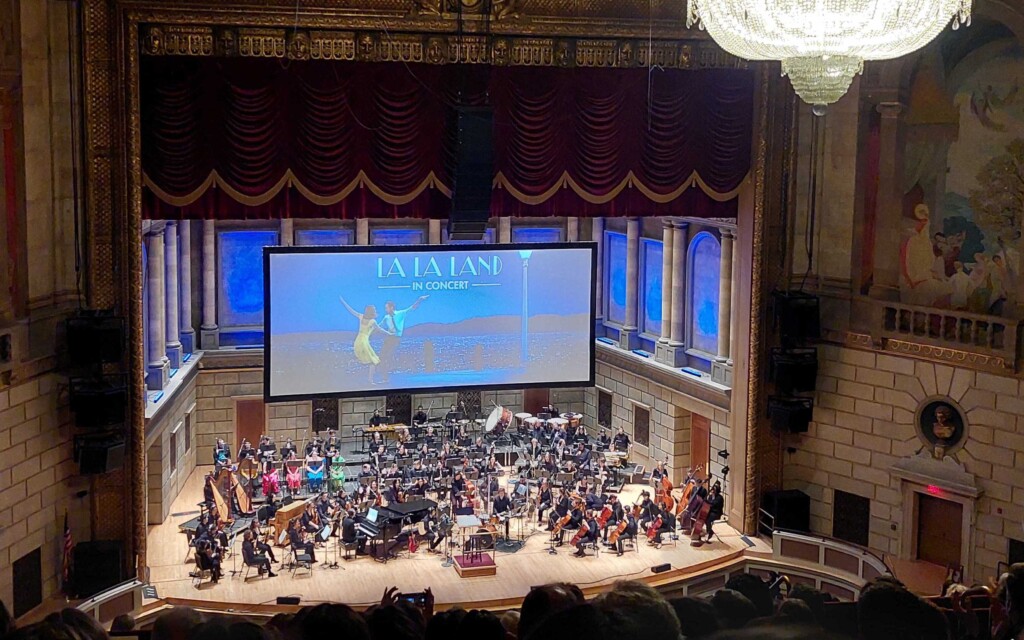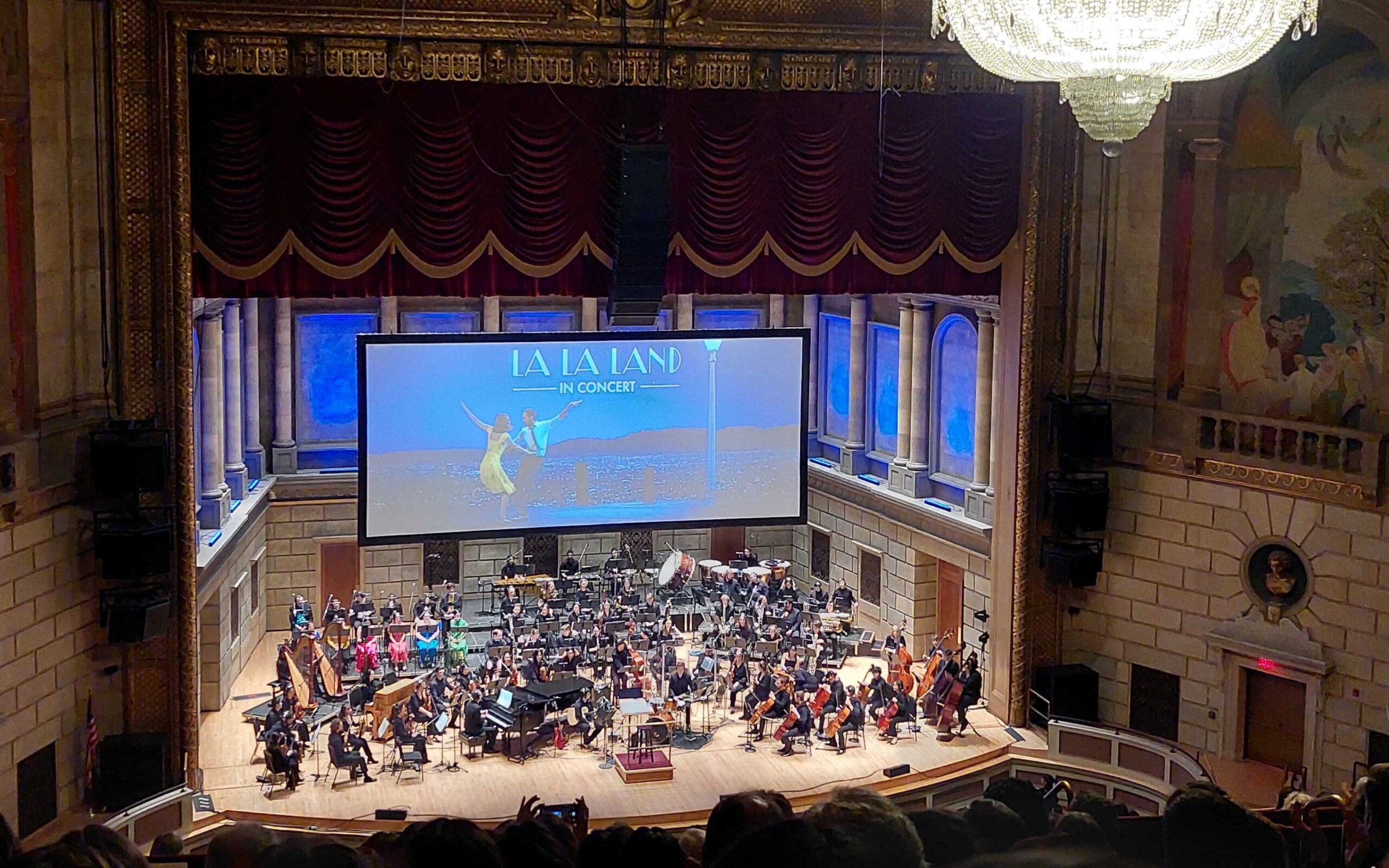It’s the first act of “La La Land” (2016). Jazz musician Seb takes aspiring actress Mia to a jazz bar to expose her to the genre’s beauty. “You can’t hear it […] you have to see it — you have to see what’s at stake,” he insists, gesturing at the jazz band performing on stage. “Every one of these guys is composing, they’re rearranging, they’re writing […] It’s conflict, and it’s compromise, and it’s just — it’s new every time. It’s brand new every night. It’s very, very exciting.”
Despite having seen the film repeatedly, it wasn’t until I watched “La La Land in Concert” Feb. 16 that I was fully able to grasp what Seb meant.
Conducted by six-time Emmy Award-winner Mark Watters and performed by the Empire Film and Media Ensemble (EFaME), the concert breathed new vitality into Justin Hurwitz’s Oscar-winning score and provided extraordinary value for old and new fans alike. As a seasoned “La La Land” enthusiast, the difference was stark. Although the visuals remained the same, the live orchestra and chorus accompanying a scoreless version of the film on the big screen gave it a whole new dimension. And unlike “Harry Potter and the Half Blood Prince in Concert,” which RPO performed at Kodak Hall last semester, this show made full use of every tool at its disposal, including lighting and sound design. Director and writer Damien Chazelle is unparalleled at encapsulating the visceral experience of live music in film, but seeing the musical push and pull — collaboration, competition, even whiplash, some might say — unfold on stage for a sold-out audience at Kodak Hall was an out-of-body experience.
This was “La La Land” on steroids. Eastman Ph.D. student and “La La Land In Concert” classical/electrical guitarist Isaac Romagosa attributes the show’s success to the presence of a live orchestra. “I love performing with an orchestra because […] all the details are super big,” he said, speaking of the show’s larger-than-life scale. The fireworks at the end of “Someone in the Crowd” were a little more dazzling, the confetti blown into Mia’s hair sparkled a little brighter, the s35mm cinematography was just a tad dreamier, and the imitation technicolor felt slightly more saturated.
Throughout the film — particularly during the musical numbers — the onstage lighting morphed to correspond with the dominant colors on screen. They turned green and red during Gosling’s begrudging Christmas Eve performance, a deep blue as Gosling and Stone waltzed at the planetarium, a twilight purple during Gosling’s solo at the pier, and a summery orange during “Summer Montage/Madeline.” Red and yellow lighting and a live chorus accompanying John Legend’s vocals made “Start a Fire” all the more jarring. Teal lighting to match the curtains behind Mia and Seb welcomed the audience into their apartment and their “City of Stars” duet. The lighting accentuated Mia’s salmon pink and Seb’s midnight blue color palettes, and effortlessly blended them together during their joint scenes, symbolizing their union as well as their separation. Most impressively, during “Epilogue,” the lighting seamlessly cycled through every color featured in the montage, making the fantasy of their alternate life together more vivid — and heartbreaking.
However, the lighting design for the concert went beyond the ambient washes of color behind the screen. As Seb played his and Mia’s theme at his new bar, pianist Dariusz Terefenko played it solo on stage. A single spotlight shone on both Gosling in the film and Terefenko on stage, and both Mia and the Kodak Hall audience held their breath. And then the lights gently faded up, jolting the audience and the on-screen duo back to reality and separating them once more.
The parallels between what was unfolding on screen and what was happening at Kodak Hall — both on stage and in the audience — expanded the world of the film beyond the screen. There are three things that both Kodak Hall and “La La Land” have an abundance of: live music, impeccable lighting, and applause abound. And so, when the auditorium dimmed and the orchestra performed “Overture,” I saw Mia and Seb’s relationship — real and imagined — play out before my eyes. When the real audience at Kodak burst into applause alongside the fictional audience at Seb’s concert, when the chorus sang Mia’s roommates’ lines from “Someone in the Crowd” while wearing dresses that matched the characters’ jewel-toned outfits, when Terefenko (and Gosling) left the final note incomplete at the end of “Epilogue,” when there were audible sniffles, sighs, and sobs in the theater, it became delightfully difficult to separate fact from fiction.
My only criticism of this blurring of boundaries is that it was often difficult to discern between the on-stage chorus and the film’s original vocals. For someone less familiar with every earnest crack and breathy exhale in Stone and Gosling’s performances, it might not have been immediately clear whether the chorus was only performing supporting parts or the lead vocals as well. I, for one, did not realize that Mia’s roommates were being played by members of the chorus until one of the vocalist’s British accents seemed slightly off.
Although audiences should not need to have listened to the soundtrack on loop to be able to distinguish where the recorded score ended and the live score began, perhaps the blending of vocal performances was the point. The concert experience preserved what the film’s mix engineer Marius de Vries has called “the integrity and fragility of the vocal performances” by retaining Gosling and Stone’s vocals while elevating the “realness of the instrumental performances.”
This soundtrack’s “realness” was reinforced by the contrast between live and recorded instrumentals in the concert. The orchestra did not perform the parts of the soundtrack that were portrayed as digital recordings within the film, such as the characters listening to the radio or playing vinyl. For example, in comparison to the back of the truck sliding open during “Another Day of Sun” while musicians played timpani drums live on stage, the song Seb was listening to in his car after the opening song immediately and intentionally fell flat. It was also clear that the orchestra was improvising and collaborating in real-time, further demonstrating the “realness” of the performance.
“We were following the conductor, but even if you want to play what’s written, if there’s different musicians playing it, it’ll never sound the same — and that’s the cool thing about music,” Romagosa said. For a movie about bringing jazz back to life, the concert felt like a testament to the power of live music.
I am envious of anyone whose first experience watching the film was in concert. Having live orchestration accompany the film brought its visual, thematic, and, of course, musical direction to life. And, although making every track a front-and-center spectacle sacrificed the relative invisibility of the background score, it amplified an otherwise overlooked theme of the film: the magic of live performance. It reminded me that “La La Land” is not just an homage to Hollywood and jazz but also to the very experience of witnessing musicians performing in front of you and the collective effervescence of being part of an audience.
If the medium is the message, this remediation of the film with a live orchestra was the best possible love letter to live music. “La La Land” has never shined so brightly.


